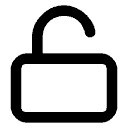When citing or referring please provide this DOI:10.6084/m9.figshare.6714038nnRecently, I gathered data from the Bielefeld Search Engine BASE on the percentage of journal articles, books and doctoral theses published Open Access, licensed under Creative Commons Licenses and under Open License between 2013 to 2017.nnSince dissertations have been published electronically and Open Access for a long time, they have traditionally been a document type that was more Open Science compliant than others. For example, the Open Access repository software OPUS, which is widely used in Germany, was in earlier years used exclusively for the electronic publication of doctoral theses. Unfortunately, this pioneering role could not be held: A look at the data provided by BASE shows that the Open Science penetration among theses published stagnates. BASE knows three categories of accessibility: Open Access, Unknown, Non Open Access. In the following tables and graphs, figures reported as “Open Access” have been categorised by BASE as Open Access. The following tables show data from BASE as follows:
- Indexed theses, books and journal articles (2013-2017)
- Indexed theses, books and journal articles published Open Access (2013-2017)
- indexed theses, books and journal articles under Creative Commons licenses (2013-2017)
- indexed theses, books and journal articles, which are published under Open Licenses in the sense of the Open License, i. e. reflect terms of use of the Open Source (2013-2017)
Open Licenses mean licenses that fulfil the requirements of the Open Definition. This applies only to two Creative Commons licenses: CC-BY and CC-BY-SA.
| 2013 | 2014 | 2015 | 2016 | 2017 | |
| Doctoral Theses total | 101,264 | 108,253 | 111,555 | 108,697 | 77,731 |
| Doctoral Thesesnpublished Open Access | 43,322 | 51,397 | 50,671 | 50,427 | 36,935 |
| Doctoral Thesesnunder Creative Commons Licenses | 9,011 | 10,930 | 11,850 | 12,935 | 9,886 |
| Doctoral Thesesnunder Open Licenses | 1,849 | 1,959 | 2,339 | 1,959 | 1,432 |
| Books total | 68,257 | 64,982 | 67,130 | 61,236 | 46,187 |
| Booksnpublished Open Access | 13,847 | 15,405 | 23,007 | 17,232 | 15,643 |
| Booksnunder Creative Commons Licenses | 2,519 | 2,869 | 3,515 | 4,611 | 5,940 |
| Booksnunder Open Licenses | 467 | 533 | 815 | 1,832 | 2,890 |
| Journal Articles total | 1,768,791 | 1,957,058 | 2,131,604 | 2,005,268 | 1,696,182 |
| Journal Articlesnpublished Open Access | 782,801 | 940,576 | 1,175,890 | 1,117,097 | 1,035,434 |
| Journal Articlesnunder Creative Commons Licenses | 175,887 | 233,968 | 301,124 | 358,274 | 313,227 |
| Journal Articlesnunder Open Licenses | 84,548 | 105,820 | 141,038 | 168,626 | 175,587 |
| 2013 | 2014 | 2015 | 2016 | 2017 | |
| Doctoral Thesesnpercentage: Open Access | 43% | 47% | 45% | 46% | 48% |
| Doctoral Thesesnpercentage: CC-licensed | 9% | 10% | 11% | 12% | 13% |
| Doctoral Thesesnpercentage: Openly licensed | 2% | 2% | 2% | 2% | 2% |
| Booksnpercentage: Open Access | 20% | 24% | 34% | 28% | 34% |
| Booksnpercentage: CC-licensed | 4% | 4% | 5% | 8% | 13% |
| Booksnpercentage: Openly licensed | 1% | 1% | 1% | 3% | 6% |
| Journal Articlesnpercentage: Open Access | 44% | 48% | 55% | 56% | 61% |
| Journal Articlesnpercentage: CC-licensed | 10% | 12% | 14% | 18% | 18% |
| Journal Articlesnpercentage: Openly licensed | 5% | 5% | 7% | 8% | 10% |
Although doctoral theses already had a high share of Open Access by 2013 (43%), by 2017 it had risen by only 5% (2017: 48%). At the same time, the proportion of books published Open Access rose by 14% (from 20% to 34%) and articles by 17% from 44% (2013) to 61% (2017). The same effect can be seen in the proportion of CC-licensed items: Their share rose by 4% (from 9% to 13%) for doctoral theses, by 9% for books (from 4% to 13%) and 8% for articles (from 10% to 18%) between 2013 and 2017. However, the share of openly licensed items is most pronounced: it did not increase for doctoral theses, but remained at 2% between 2013 and 2017; in the same period it increased by 5% (from 1% to 6%) for books, and by 5% (from 5% to 10%) for articles. Even though this figure is illustrative, they show that although dissertations were published in earlier years more compatible with Open Science than books and articles, their penetration with Open Science stagnated and today they are compared with books and articles less compatible with Open Science.
The proportion of books available under CC licenses rose sharply compared to the number of doctoral theses licensed under CC licenses and reached the same percentage in 2017.
As the proportion of doctoral theses available under Open licenses stagnated the percentage of openly licensed books outnumbered theses already in 2016.
The data to this posting is available as:
Ulrich Herb (2018). Numbers of Articles, Books and Dissertation theses indexed in BASE and percentages of items published Open Access, under Creative Commons Licenses and under Open Licenses (2013-2017) [Data set]. Zenodo.nOnline: DOI:10.5281/zenodo.1189807
Copyright note: Icon available under MIT License from https://www.iconfinder.com/icons/2561489/unlock_icon

Graduate sociologist, information scientist (PhD degree), associate of scidecode science consulting – De Castro, Herb, Rothfritz GbR, working for the Saarland University and State Library (Germany)


